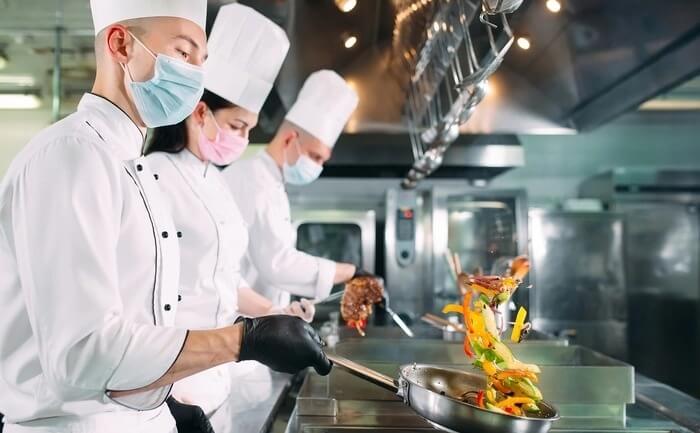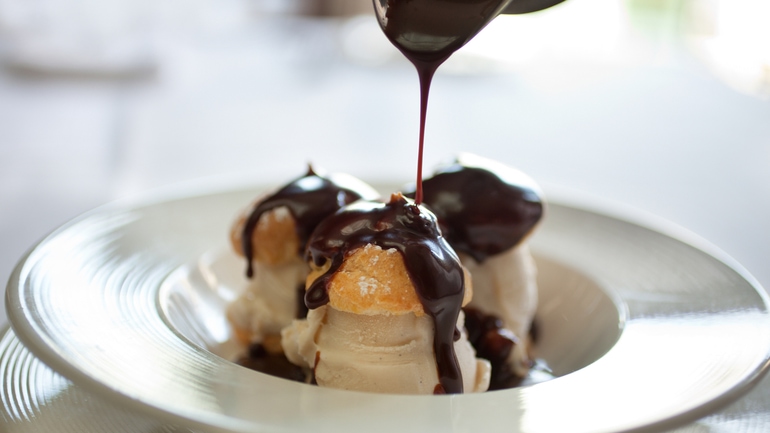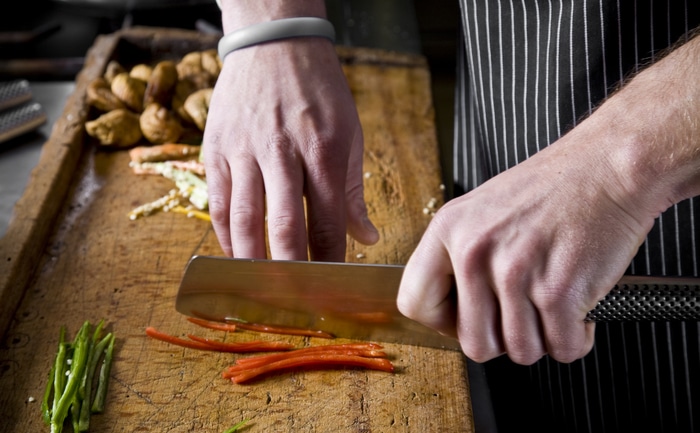Whether you’re a chef, restaurateur, or server, you need to be familiar with a vast vocabulary of culinary terms to communicate with teammates and customers.
If, for example, you ask a colleague to broil something, when you actually want it braised, you could end up with costly food waste and unhappy customers. We’re here to help you avoid kitchen crises by:
- Explaining why it’s important to know culinary terms, and
- Defining 104 popular cooking terms
Let’s get started.
Why It’s Important to Know Your Culinary Terms
If you work in a restaurant, you need to know the proper terms for cooking techniques, ingredients, dishes, and jargon. Culinary terms are a common language that keeps everyone on the same page.
Some people you’re working with may be self-taught, while others have gone to culinary school. If you’re a chef trying to communicate with fellow back of house (BOH) team members but are using culinary terms you’ve made up, you’re creating a recipe for disaster. Using a shared vocabulary helps maximize kitchen efficiency.
Culinary terminology isn’t just valuable to kitchen staff. Servers also need to be able to understand how food is prepared and be ready to explain cooking methods, ingredients, and flavors to customers who inquire about menu items.
When everyone uses the same restaurant lingo, you can ensure consistent execution of recipes and service.
104 Popular Cooking Terms and Restaurant Jargon
Without further ado, here are popular food terms you should know if you work in a restaurant – whether you’re in the kitchen or in a customer-facing role.
# Culinary Terms
- 86: Noun meaning your restaurant is out of a menu item, or a verb meaning to remove an item from a dish.
A to D Cooking Terms
A Cooking Terms
- A la carte: French for “of the menu” and refers to dishes that are priced separately on a menu, rather than served together for a set price.
- A la plancha: Spanish method of cooking food on a griddle.
- Acidulation: Making something sour, usually by adding lemon juice.
- Al dente: Italian for “to the tooth.” Describes cooking something until it’s edible but still firm. Traditionally, this term is used to describe pasta.
- Appetizer: Small dish that’s served before the main course.
- Au gratin: French for “by grating,” which means covering something with breadcrumbs and cheese and baking it until browned.
- Au sec: Reducing the liquid in a dish so that it’s “nearly dry” (the French translation of the phrase).

B Culinary Terminology
- Back of house (BOH): The back of the restaurant, where the kitchen, offices, and storage are located.
- Bain-marie: Cooking method that involves warming delicate foods in a dish above boiling water to avoid direct contact with the heat so as to prevent curdling.
- Bake: Cooking food using dry heat in an oven.
- Barbecue: Grilling food (usually outdoors) over a wood or charcoal flame.
- Bard: Wrapping lean meats in fat or bacon while roasting to prevent them from drying out.
- Baste: Dripping or covering food with liquid, usually stock, while cooking to enhance its flavor and prevent it from drying out.
- Beat: Stirring ingredients in a circular motion with a utensil, mixer, or whisk until combined.
- Beurre blanc: French butter sauce made with shallots and white wine that’s typically served with seafood.
- Blanch: Boiling food for a short amount of time and then placing in ice water to stop further cooking.
- Bouquet garni: See “sachet.”
- Braise: Frying food slightly and then letting it stew.
- Brine: A salt water mixture that makes meat more tender when soaked in the solution.
- Broil: Baking with maximum heat, usually only for a short amount of time.
- Brown: Cooking food until it turns brown.
- Butterfly: Cutting meat (typically poultry) down the middle without slicing the center and opening both sides so that it looks like a butterfly. This slicing method makes meat easier to cook more evenly.
C Food Terms
- Caramelize: To cook sugar until it turns to syrup, or to cook food until it browns and develops a caramel flavor (like caramelized onions).
- Chiffonade: Leafy greens or herbs that are thinly sliced so they can be used for a garnish.
- Chit (see also: “ticket”): Restaurant jargon for an order placed into the point of sale system.
- Chop: To roughly cut food into bite-sized portions.
- Comp: To offer a complimentary dish or item to a customer, whether to correct an error or give the guest special treatment.
- Concasse: Preparing tomatoes by removing the peel and seeds, and roughly chopping them.
- Confit: Cook meat, usually duck, slowly in its own fat.
- Consommé: Either the process of using egg whites to remove fat from a dish, or a type of clear, broth soup.
- Coddle: Cooking eggs, either in or out of the shell, in water that is slightly cooler than the boiling point.
- Core: To remove the stem and seeds from the center of a fruit, like a pear or an apple.
- Cream: To beat sugar and a fat (like softened butter), until they reach a creamy texture.
- Crush: To mash an ingredient with a utensil.
- Cube: To chop food into small, half-inch cubes.

D Culinary Words
- Dash: ⅛ of a teaspoon.
- Deglaze: Removing food remnants in a pan with a hot liquid with the purpose of using the flavorful remains to create a sauce.
- Degrease: Getting rid of the fat that forms on top of a hot liquid like a soup.
- Dice: Chopping food into fine pieces, usually no more than an eighth or a quarter of an inch in size.
- Dollop: A semi-solid food, like sour cream, measured by the spoonful.
- Dredge: Coating raw food, like meat, with breadcrumbs or flour, before frying.
- Dress: To cover a salad or other food in a sauce.
- Drizzle: Pouring a liquid ingredient, like oil or dressing, over food using a back and forth motion.
- Dust: To sprinkle with powdered food, like powdered sugar.
E to L Culinary Terms
E Chef Terms
- Emincer: French for “to mince,” meaning to slice thinly.
- Emulsify: To combine liquids that usually wouldn’t stay mixed together due to their properties. Egg yolk, for example, helps emulsify oil and vinegar to turn it into mayonnaise.
- Entree: The main course.
F Culinary Terms
- Fillet: Removing bones from meat, or cutting meat into a thin slice.
- Flambé: To cover a dish in alcohol and light it on fire during cooking or before serving for enhanced flavor and dramatic effect.
- Fold: Combining light and heavy ingredients, like whipped cream and flour, by stirring the mixture from bottom to top.
- Frenching: Removing meat from the bones of a rack of lamb, beef, or other meat, for presentation purposes.
- Front of house (FOH): The front of the restaurant, where guests are served and the host and servers work.
- Full service restaurant (FSR): A restaurant in which guests are seated and waited on, as opposed to a quick service restaurant.
G Cooking Terms
- Glaze: To cover food in a liquid, sometimes a sauce, egg whites, or jelly, to add a glossy coat.
- Grate: To slice food into small slivers using a grater.
- Grease: Coating a dish in oil or butter so that food can easily be removed from the pan after it’s been cooked.
- Grill: Equipment used to cook food on a flame, typically outdoors, or the cooking technique in which a grill is used to cook food. Grills can run on charcoal, wood, gas, or electricity, with each fuel providing its own flavor.
H Culinary Terminology
- Hors-d’oeuvre: French for “outside of the meal,” which refers to bite-sized appetizers served before the main meal.
- Hull: To remove the leaves and stem from a strawberry.
I Food Terms
- Infusion: Mixing an ingredient in liquid, typically alcohol or oil, to extract its flavor and infuse it with the liquid.
- In the weeds: Restaurant industry jargon meaning being overwhelmed or busy.

J Culinary Words
- Julienne: To slice vegetables into thin, long pieces.
- Jus: French for “juice,” which refers to meat drippings created while cooking that are usually served as a gravy.
K Culinary Terminology
- Knead: To mix dough, either manually or with a mixer.
L Culinary Terms
- Leaven: To help dough rise by adding a gas (also known as a leavening agent), like baking powder or yeast, and giving it time to grow.
M to R Culinary Terms
M Cooking Terms
- Macerate: To soften fruit in liquid and sugar.
- Marinate: To soak meat in flavored liquid, like a sauce, so that it absorbs the flavor.
- Mince: Cutting something, like garlic, into the smallest pieces possible.
- Mise en place: French for “putting into place,” meaning the preparation of a chef’s station before cooking by organizing and chopping ingredients that are needed for service.
- Mull: To steep a beverage, typically alcoholic, with spices and fruit ingredients like nutmeg or orange juice.
P Food Terms
- Pan fry: To cook ingredients in a lightly greased pan.
- Parboil: Partially cooking food by boiling it, in preparation for another cooking technique.
- Parcook: Partially cooking food with a method other than boiling.
- Pipe: To decorate food, typically a pastry, with icing by putting the icing into a piping bag and then using it to draw shapes.
- Poach: A popular egg cooking method that involves boiling over low heat.
- Point of sale (POS) system: Critical piece of restaurant equipment that lets you input orders, process payments, keep track of inventory, manage table arrangements, see sales resorts, and more.
- Pinch: 1/16 of a teaspoon.
- Reconstitute: To add liquid back to a food that has been dehydrated, usually by immersing it in water.
- Render: Removing fat from meat by cooking it over low heat.
- Purée: To liquefy or mash food until it reaches a homogenous, smooth texture.
Q Culinary Terminology
- Quick service restaurant (QSR): A restaurant in which customers have to serve themselves when they reach their table, like a fast food venue.
R Culinary Words
- Roast: Baking meat in an oven.
- Roux: Fat and flour mixture traditionally used to thicken sauces or soups.

S to Z Culinary Terms
S Chef Terms
- Sachet (a.k.a. “bouquet garni”): Herbs, like rosemary and thyme, placed in a cheesecloth and immersed in soup during cooking to add flavor.
- Sauté: To cook food in a well-greased pan over medium-high heat.
- Scald: Heating liquid until just before it boils.
- Score: Making shallow incisions near the surface of a food.
- Sear: To quickly cook meat over high heat just until the exterior browns so that the meat’s flavors and juices are sealed in.
- Shred: Grating food into large, long pieces.
- Simmer: To boil liquid in a pot and then lower the heat so that the bubbles disappear.
- Skim: Getting rid of fat that has formed on a liquid’s surface.
- Slice: To cut food into pieces with a knife.
- Smidgen: 1/32 of a teaspoon.
- Steam: To cook food using steam.
- Steep: To infuse the flavor of a dry food, like tea, into a liquid, like water, by soaking it in a hot liquid.
- Stew: Cooking food in a liquid for a long time over low heat.
T Culinary Terms
- Table turn: When customers at a restaurant leave the table and new customers can be seated.
- Ticket (see also “chit”): Restaurant jargon for an order placed into the point of sale system.
- Truss: Tying poultry limbs together, commonly with string or pins, so that they stay still while cooking.
V Culinary Terminology
- Velouté: Sauce created by mixing roux with stock.
W Culinary Words
- Whip: Adding air into food by beating it.
- Whisk: Manually beating ingredients with a whisk or fork.
Z Culinary Terminology
- Zest: A noun meaning the peel of a citrus, or a verb meaning to grate the peel of a citrus.
When you and your team understand all of these important culinary terms, you’ll be able to communicate effectively and keep customers satisfied. Happy studying!
Download our free inventory template
Sign up for our free weekly TouchBistro Newsletter







